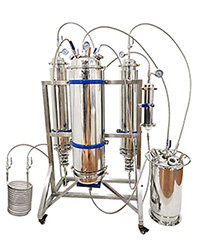-
WhatsApp
-
Email
- A total of 1 pieces of information
Closed Loop Extraction - Closed Loop Extraction machine
What is a closed-loop extraction system?
A closed loop system is an extraction method used to make cannabis concentrate. During this process, no solvents are exposed to the open air but are contained in a closed-loop system. It is performed by a professional laboratory using well-trained technologies, some of which have a chemistry degree and use industrial-grade equipment.
What does the closed-loop extraction kit do?
Closed-loop extraction systems have been used in the production of perfumes, food additives and beauty products for decades. Until recently, this method was used to produce hemp oil. It is much safer than open explosives. Using the system is a safer method of using flammable solvents. The extraction machine has no openings, so it can successfully contain solvents in a safe and enclosed environment. With a closed-loop system, extraction artists can reuse solvents and reduce the risk of explosion.
Most solvent-based concentrates can be made using a closed-loop system. What makes this system the best is the quality of product that can be made. With the correct vacuum oven, blasting chamber, and other recovery systems to extract, CBD levels can be as high as 80-90% while keeping the levels of solvents and impurities low.
How Does a Closed-Loop Extraction Equipment Work?
The closed loop extraction machine is a professional setting that requires constant pressure and operating control valves. It consists of a large tank filled with solvent, an auxiliary pipe for controlling and controlling blasting, a recovery tank, a refrigerant pump, a recovery pump, and a refrigerant scale that effectively measures the weight of the recovery tank. To use butane as a solvent, the unit must also have an oven and a pump. The closed loop system operates by placing the ground hemp plant material into an extraction tube. A pressurized solvent tank is connected to the extraction tube. The solvent will remain under pressure throughout the process. It is controlled by fixtures and valves.







